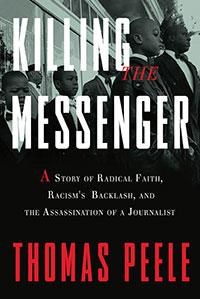When Thomas Peele came into the CPJ offices last week to discuss Killing the Messenger, his book about the murder of journalist Chauncey Bailey, he described a story that was layered with scandal, including a polygamous cult, bankruptcy, kidnapping, rape, a flawed confession, leaked evidence, and secret alliances–not to mention the aggressive attack on a free press. Peele, motivated in part by the blatant demonstration of corruption in the investigation into Bailey’s death, intended to reveal the truth about the circumstances surrounding the case. Accompanying Peele at CPJ was our own senior adviser for journalist security, Frank Smyth, who became involved in the case as a CPJ representative.
Chauncey Bailey was working as a journalist in Oakland, California, when he was gunned down walking from his home to his office at the Oakland Post on August 2, 2007. At the time of his murder, Bailey was investigating the finances at Your Black Muslim Bakery, a business at the center of a cult group with mafioso tendencies led by Yusuf Bey IV. Though Bey was not the one to pull the trigger, he was believed by most to be responsible for Bailey’s death.
Immediately following Bailey’s murder a group of journalists and media specialists, including Peele, started the Chauncey Bailey Project. The project’s premise, its website states, was that “You can’t kill a story by killing a journalist.” Its first goal was to begin by finishing Bailey’s work on the bakery. The group began to put the bakery’s finances as well as the details surrounding Bailey’s murder under more scrutiny. The project’s effort eventually shamed the local district attorney into retrying the case; Yusuf Bey IV and Antoine Mackey were convicted of first-degree murder in June 2011.
In Killing the Messenger, Peele deconstructs the web of corruption and conspiracy that surrounded Chauncey Bailey and his reporting on Your Black Muslim Bakery. One example from the book that he shared at CPJ includes a colorful scene from a bar fight at a strip club in San Francisco. Explaining how Bey and some of his fellow brothers traveled to San Francisco because that type of behavior was not acceptable in Your Black Muslim Bakery’s community, Peele read an excerpt in which Bey becomes irate at the owner of the club for extra costs incurred and then is genuinely shocked when the owner does not recognize his name. Bey mistakenly believed he was as much of a big deal in San Francisco as in Oakland.
Peele and Smyth emphasized that the fact that Bailey was the first journalist to be murdered in the United States in 14 years was enormously important. The journalistic community was motivated at the time by the need to set a precedent and establish a constitutional mandate for journalists concerning their right to participate in a free press. “We had to do this–it wasn’t a choice; a lot of this didn’t feel optional,” Peele told CPJ.
Particularly disappointing, Peele said, was the lack of leadership from anyone in power. No one among the city’s political heavyweights spoke out about the political impact of a journalist being killed. The lack of support by the larger community was another factor that propelled him to work on the project and write the book.
This CPJ video explains how the Chauncey Bailey Project–in which journalists banded together to conduct an independent investigation and used media as an advocacy tool–is a model for combating impunity in journalist murders.
